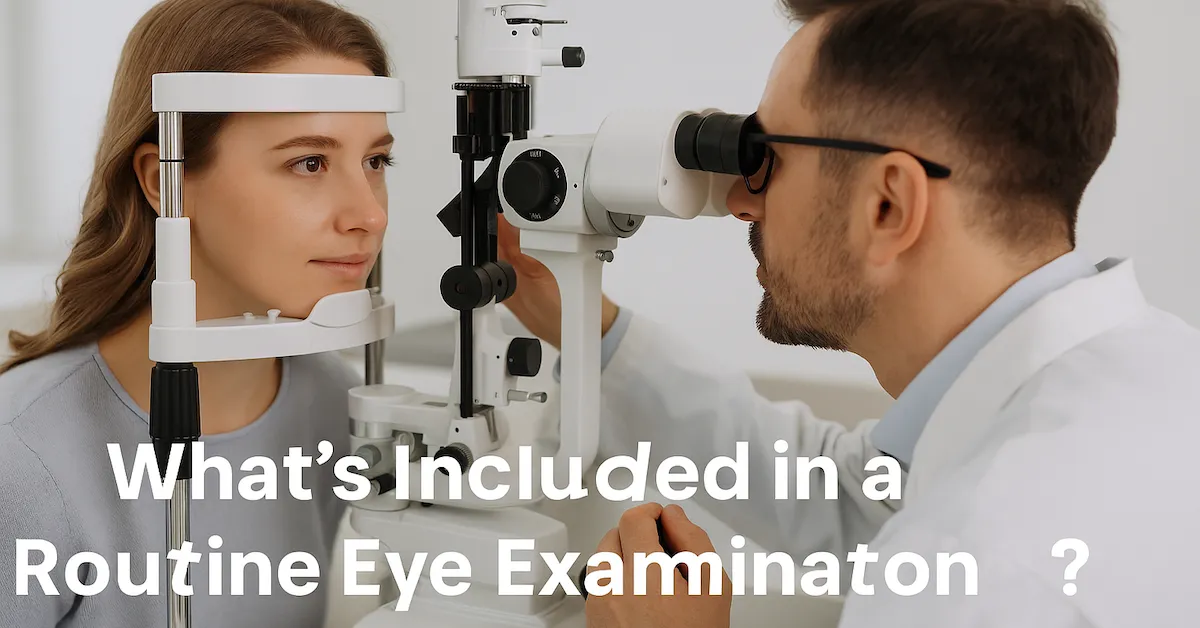
What’s Included in a Routine Eye Examination?
Regular eye exams are one of the most important steps you can take to protect your vision and overall health. Many people assume they only need an eye test when their vision becomes blurry, but routine eye examinations go far beyond that. These checkups help detect early signs of eye conditions, track vision changes, and even uncover underlying health problems that may not show symptoms yet. Understanding what happens during a comprehensive eye exam can help you feel more prepared and confident about scheduling your next appointment.
Why Routine Eye Exams Are Important
Your eyes do more than help you see clearly they can also reveal signs of diseases like diabetes, hypertension, or high cholesterol. A routine eye exam allows your optometrist or ophthalmologist to detect these issues early, often before you notice any symptoms. Catching vision changes or eye conditions early makes treatment more effective and helps prevent permanent damage. Even people with perfect eyesight should schedule regular exams to maintain optimal eye health and prevent long-term complications.
Initial Health and Vision History
The first step of a routine eye exam usually involves discussing your medical history. Your doctor will ask questions about your overall health, any medications you take, and your family’s history of eye disease. You’ll also be asked about symptoms such as dryness, headaches, or changes in vision. This information helps your doctor identify potential risk factors and tailor the exam to your needs.
If you wear glasses or contact lenses, your current prescription will be reviewed to see if any adjustments are needed. Lifestyle factors, such as how much time you spend on screens or outdoors, also play a role in determining your eye care plan.
Vision Tests and Refraction Assessment
Next, your visual acuity will be tested using an eye chart. You’ll read letters or symbols of different sizes from a distance to determine how clearly each eye can see. This helps identify nearsightedness, farsightedness, or astigmatism.
If your vision needs correction, a refraction test will be performed to determine the exact prescription for your glasses or contact lenses. During this test, you’ll look through a device called a phoropter while the doctor switches lenses and asks which options look clearer. This step ensures your vision correction is precise and comfortable.
Eye Muscle and Coordination Testing
Good vision depends on how well your eyes work together. Eye muscle testing evaluates how your eyes move and focus as a team. Your doctor might ask you to follow a moving object or focus on a target while it moves in different directions. This test helps identify problems such as eye strain, double vision, or coordination issues, which can affect reading or depth perception.
Pupil and Peripheral Vision Testing
Your pupils naturally react to light, and testing this response can reveal important information about your eye and brain health. Your doctor will shine a small light into your eyes to check how your pupils expand and contract.
Peripheral vision testing, also known as visual field testing, measures how well you can see objects outside your direct line of sight. Loss of peripheral vision may be an early sign of glaucoma or other neurological conditions, making this step an essential part of the exam.
Slit-Lamp Examination
A slit lamp is a microscope with a bright light that allows your doctor to examine the front parts of your eye in detail, including the cornea, iris, and lens. This test helps detect infections, inflammation, scratches, or early signs of cataracts. By using different magnification levels, the doctor can identify even the smallest irregularities on the eye’s surface or within the lens structure.
Retinal and Optic Nerve Evaluation
To assess the back of the eye, your doctor may use special lenses or digital imaging to inspect the retina and optic nerve. This part of the exam is crucial for identifying conditions such as macular degeneration, diabetic retinopathy, or retinal detachment. Sometimes, your eyes may be dilated with special drops to provide a clearer view of the inner structures. While dilation temporarily causes light sensitivity, it allows for a more comprehensive examination.
Intraocular Pressure Measurement
Checking intraocular pressure, also known as tonometry, is another key component of a routine eye exam. This test helps detect glaucoma, a condition caused by increased pressure inside the eye that can damage the optic nerve. There are different methods to measure eye pressure, including a quick puff of air or a gentle touch with a specialized instrument. The procedure is painless and takes only a few seconds.
How Often You Should Schedule an Eye Exam
How often you need an eye exam depends on your age, vision history, and risk factors. As a general guideline:
Children and teens: every 1 to 2 years to ensure proper visual development.
Adults under 40: every 2 years if no vision problems exist.
Adults over 40: annually, as age increases the risk of eye diseases like glaucoma and cataracts.
People with diabetes or a family history of eye disease: yearly or as recommended by a specialist.
Regular checkups help detect changes early, allowing for prompt treatment and preserving long-term vision.
Conclusion
A routine eye examination is much more than a quick vision check. It’s a thorough evaluation of your eyes’ overall health, including tests for visual clarity, muscle coordination, and internal structures. Early detection of eye conditions and systemic diseases through routine exams can make a lasting difference in your quality of life.
If you’re due for your next checkup, Bellasee offers comprehensive eye examinations designed to protect and enhance your vision. Their experienced professionals use modern diagnostic tools to provide accurate results and personalized care. With Bellasee, you can take the first step toward maintaining healthy eyes and clear vision for years to come.